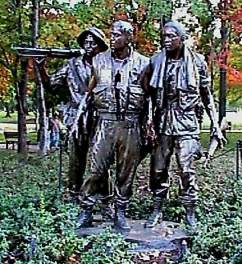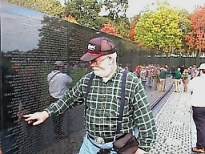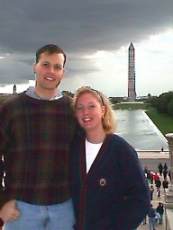A Day to Remember
In Washington DC
October 24, 1999
My  second
trip into Washington was to pay my respect to those I had known
and who have passed on. My two delightful friends, Christina and
Stefan, accompanied me on my way through the memorials. It was a
blustery day with a dark threatening sky that seemed to reflect
the mood of the trip. Our first stop was at the Vietnam Memorial
Wall. A high school buddy and I, having agreed to enter the
service on the buddy program which meant we would be assigned
together, couldn't agree on which branch of service to join. As
neither would give in, Barry joined the Navy and I went off to
the Air Force. He died in 1969 while trying to make a landing on
some now-forgotten shore in Vietnam. The names are arranged in
accordance with the year that they died, so an index book is
necessary in order to find any particular name. As I stood there
looking at the
second
trip into Washington was to pay my respect to those I had known
and who have passed on. My two delightful friends, Christina and
Stefan, accompanied me on my way through the memorials. It was a
blustery day with a dark threatening sky that seemed to reflect
the mood of the trip. Our first stop was at the Vietnam Memorial
Wall. A high school buddy and I, having agreed to enter the
service on the buddy program which meant we would be assigned
together, couldn't agree on which branch of service to join. As
neither would give in, Barry joined the Navy and I went off to
the Air Force. He died in 1969 while trying to make a landing on
some now-forgotten shore in Vietnam. The names are arranged in
accordance with the year that they died, so an index book is
necessary in order to find any particular name. As I stood there
looking at the name carved in stone,
a feeling of melancholy came over me. I wonder what he would have
become had it not been for the war. There are over 58,000 names
on that wall. I had never had the massive loss caused by that war
driven home so hard, as I did walking along, watching row after
row of names pass by me. We walked across the street and visited
the Lincoln Memorial. The statue is impressive and quite a bit
larger then I had expected. Many of his speeches are inscribed on
the inner walls. From the top step
I looked out over the reflection pool to the Washington Monument
which was presently under repairs. I snapped a picture of my
friends. So young and innocent. I wondered how many names on how
many walls would be added by the time they had reached my age. My
friends then drove me to my next remembrance. Arlington Cemetery,
created by an angry Congress, infuriated that General Robert E.
Lee was to accept punishment for his part in leading the Army of
Northern Virginia during the War between the States, ordered
Union dead be buried in the rose garden of his home. It was
reported that
name carved in stone,
a feeling of melancholy came over me. I wonder what he would have
become had it not been for the war. There are over 58,000 names
on that wall. I had never had the massive loss caused by that war
driven home so hard, as I did walking along, watching row after
row of names pass by me. We walked across the street and visited
the Lincoln Memorial. The statue is impressive and quite a bit
larger then I had expected. Many of his speeches are inscribed on
the inner walls. From the top step
I looked out over the reflection pool to the Washington Monument
which was presently under repairs. I snapped a picture of my
friends. So young and innocent. I wondered how many names on how
many walls would be added by the time they had reached my age. My
friends then drove me to my next remembrance. Arlington Cemetery,
created by an angry Congress, infuriated that General Robert E.
Lee was to accept punishment for his part in leading the Army of
Northern Virginia during the War between the States, ordered
Union dead be buried in the rose garden of his home. It was
reported that  one statesman remarked "Let the howls of the
Union dead haunt him the rest of his life". The wars that
followed brought far more dead to these hallowed grounds then was
originally ever considered. One of them was my own father who,
along with my mother, is entombed here. The qualifications for
being buried in Arlington are complicated and steeped in military
and political tradition, but the main requirement is to have
served with distinction during war time. My father rose to the
rank of Colonel, during which time he served as a Battalion
commander in the Airborne Artillery. Although seriously wounded
in the battle for Num Fore near New Guinea, he lived until 1994.
He passed away 20 days after my mother's death. Work had kept me
away from the services so this was to be my first visit to my
parent's final resting place. As we arrived, my guides advised
that vehicles were
one statesman remarked "Let the howls of the
Union dead haunt him the rest of his life". The wars that
followed brought far more dead to these hallowed grounds then was
originally ever considered. One of them was my own father who,
along with my mother, is entombed here. The qualifications for
being buried in Arlington are complicated and steeped in military
and political tradition, but the main requirement is to have
served with distinction during war time. My father rose to the
rank of Colonel, during which time he served as a Battalion
commander in the Airborne Artillery. Although seriously wounded
in the battle for Num Fore near New Guinea, he lived until 1994.
He passed away 20 days after my mother's death. Work had kept me
away from the services so this was to be my first visit to my
parent's final resting place. As we arrived, my guides advised
that vehicles were  generally
not allowed in the park. A large parking lot adjacent to the
entrance point gave most visitors access to the shuttle buses
which traveled through the park. The exception was that if a
relative was visiting a loved one, a vehicle pass could be
acquired at the information center. The line to get a pass was
short and we were quickly served by a young lady who asked the
necessary questions, looked up my father's location and asked me
to sign the registration book. She then requested a driver's
license for identification. With pass in hand, we drove into the
park. It is huge, thousands and thousands of graves, all marked
with identical head stones in perfect uniformity, except for an
occasional stone left on the top of headstone by a Jewish
visitor. By following the detailed map given to us at the
visitor's center we quickly found the vault, on a low hill
surrounded by trees, with a bench right in front of the wall
containing the vault. A very quiet peaceful place indeed. When we
moved on, we continued to tour the park. We stopped by the tomb
of the unknown soldier. We were just in time for the changing of
the guard which occurs every half hour. It was a very stiff and
exacting relief, but when all the spit and polish was removed I
marveled that the actual exchange was pretty much the same as was
done on Air Bases where I had been assigned as a police officer.
Next to the tomb is a giant memorial amphitheater, made of
marble. It is large and bold without losing the grace of its
Roman Coliseum appearance. The marble is bright white and the
entire area is spotlessly clean. From here we proceeded to the
John F. Kennedy memorial and the internal flame. Impressive in its simplicity, the memorial draws a large crowd on any day.
generally
not allowed in the park. A large parking lot adjacent to the
entrance point gave most visitors access to the shuttle buses
which traveled through the park. The exception was that if a
relative was visiting a loved one, a vehicle pass could be
acquired at the information center. The line to get a pass was
short and we were quickly served by a young lady who asked the
necessary questions, looked up my father's location and asked me
to sign the registration book. She then requested a driver's
license for identification. With pass in hand, we drove into the
park. It is huge, thousands and thousands of graves, all marked
with identical head stones in perfect uniformity, except for an
occasional stone left on the top of headstone by a Jewish
visitor. By following the detailed map given to us at the
visitor's center we quickly found the vault, on a low hill
surrounded by trees, with a bench right in front of the wall
containing the vault. A very quiet peaceful place indeed. When we
moved on, we continued to tour the park. We stopped by the tomb
of the unknown soldier. We were just in time for the changing of
the guard which occurs every half hour. It was a very stiff and
exacting relief, but when all the spit and polish was removed I
marveled that the actual exchange was pretty much the same as was
done on Air Bases where I had been assigned as a police officer.
Next to the tomb is a giant memorial amphitheater, made of
marble. It is large and bold without losing the grace of its
Roman Coliseum appearance. The marble is bright white and the
entire area is spotlessly clean. From here we proceeded to the
John F. Kennedy memorial and the internal flame. Impressive in its simplicity, the memorial draws a large crowd on any day.

As we walked down the hill, I commented to Stefan, wondering out loud, "I wonder if we will run out of wars before we run out of land". There was one more stop on the path of remembrance of those who had touched my life and had passed on. We drove to Judiciary Square, to the National Law Enforcement Officers Memorial. Like the Vietnam wall, the National Law Enforcement Officers Memorial is a wall of names, almost 15,000 of them, representing all those who have died in the line of duty since U.S Marshall Robert Forsyth was killed in 1794. Among them was David Massel, an officer who worked with both Laura and myself on a country wide, multi-department computer group. It was strange to see his name in stone surrounded by all those other names. Several blocks away is a visitor center which offers many individual stories. As we wound up the day's activity, I was pleased that a marker had been laid in honor of those who had seen a call to duty and had met that duty. It had been a good day.
*** THE END ***
